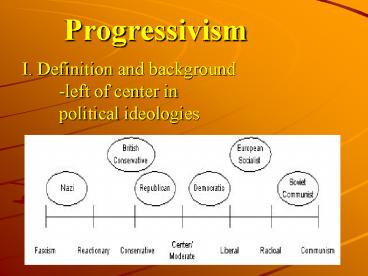Progressivism - PowerPoint PPT Presentation
1 / 12
Title:
Progressivism
Description:
Progressivism I. Definition and background -left of center in political ideologies II. Getting the Message Out -Muckrakers III. Progressivism at the city level ... – PowerPoint PPT presentation
Number of Views:597
Avg rating:3.0/5.0
Title: Progressivism
1
Progressivism
- I. Definition and background -left of center in
political ideologies
2
-egalitarianism vs. elitism -rights vs.
liberties -internal vs. external -political
pendulum/cycles of reform --cycles of reform
-general goals of Progressive reformers
--return to old founding fathers concept of
democracy --make system more equal or
egalitarian in the face of
industrialization --curb or control what
they saw as abuses of trusts or big
business
3
II. Getting the Message Out
- -Muckrakers
4
III. Progressivism at the city level
- -Settlement Houses
- --Jane Addams/Hull House
- --help assimilate inner city
- immigrants
- --political activism
5
(No Transcript)
6
IV. Progressivism at the state level
- -Robert LaFollette
- --Wisconsin Model
- - regulate Railroads
- - direct primary
- -taxation
- -unemployment
- compensation
- -child labor laws
7
(No Transcript)
8
V. Progressivism at the federal
level -politics --William McKinley --Theodore
Roosevelt (TR)
"The foremost champion of protection" is William McKinley reported the press in 1894. The congenial Republican replaced fellow Ohioan James Garfield on Ways and Means in 1880. Nine years later, losing a race for the Speaker's job, he took over Ways and Means and authored a new tariff bill. The McKinley Tariff of 1890 inaugurated the highest protectionist rates in history to that time. It also included America's first tariff reciprocity provision. Voters upset over the high tariff turned McKinley out of Congress. After serving as governor of Ohio, McKinley was brought back to national office in 1897 as the 25th President. BACK
9
(No Transcript)
10
--William Howard Taft --Woodrow Wilson
11
-Womens vote --Alice Paul --Susan B. Anthony
12
-child labor -consumer protection --Meat
Inspection Act --Pure Food Drug
Act -safety -direct election of
senators -trust busting vs. regulation -moral
control































